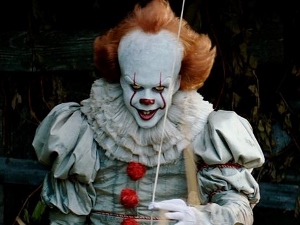It: Chapter One (2017)
[7]
If ever there was something ripe for a remake, I think Stephen King’s It would be near the top of my list. The original 1990 TV mini-series is good, but it begins to fall apart in its second half, partly for budgetary reasons. The feature-film is being remade in two parts, so we’ll have to wait a year to see if ‘Chapter Two’ improves upon the mini-series’ shortcomings, but it’s already off to a good start with ‘Chapter One’.
It: Chapter One is about a group of grade school kids who live in a town where children keep going missing, including one boy’s younger brother. The friends all have visions of Pennywise the Clown and eventually find a way to confront this sinister jokester before he kidnaps and kills again. Pennywise takes the form of your greatest fears, so he’s a bit of a shapeshifter — a point the remake makes more clear than the miniseries did. He feeds off your fear, so if you’re able to get a grip and overcome what terrifies you, you can hurt him. ‘Chapter One’ sees our group of kids, who call themselves the “Losers’ Club”, vanquishing Pennywise and vowing to come back together if he ever shows his painted face again. ‘Chapter Two’, scheduled for release next year, will pick up with the same characters as adults reuniting to confront Pennywise one last time.
Studio-produced horror films have become so uninspired, that many will greet this new It as the Second Coming by comparison. It’s not that great. But it’s good! The new film is a little bit long, spending too much time on vignettes of Pennywise terrorizing individual kids without stringing together a strong over-aching objective. The kids are clueless for a long time, with only one of the boys doing research in a library to try and figure out what is happening to them. If I didn’t already know the story, I might also have found the movie to be a little anti-climactic. So just keep in mind that we’re building toward the mid-point of a story with ‘Chapter One.’ But otherwise, It is a well-made, old-fashioned horror movie fueled by honest-to-goodness human emotion. You care about the kids. They’re losers, for Christ’s sake. One of them is holding onto hope that he’ll still find his little brother alive. All of them have assholes for parents. And it’s suggested that the lone girl of the group is being sexually abused by her father. You want to see these kids stick together and defeat not just Pennywise, but everything life has coming at them.

The child actors do a good-enough job. There’s no Haley Joel Osment, Dakota Fanning, or Elle Fanning to be found here. Editing and dubbing help get the peformances where they need to be. Jaeden Lieberher and Sophia Lillis have their dramatic moments, and audiences are sure to love the snarky boys who trade sexual barbs involving each others’ mothers. If there’s a discovery on the roster, it’s Bill Skarsgård, a young man I’ve never seen before. He does a remarkable job taking over the Pennywise role Tim Curry made so iconic in 1990. Horror fans will be inclined to pick sides, but I think there’s enough space in the world for two Pennywises. Skarsgård has the moves, the voice, and his own distinct creepiness about him.
The film takes you back to the late ’80s, literally and stylistically. Director Andy Muschietti relies largely on the classical, invisible Hollywood style here. He sets up well-composed shots and refrains from aggressive editing techniques. The scenes are purposefully staged and the soundtrack features a classical, orchestral score instead of the droning ‘sound design’ bullshit score we’ve come accustomed to in movies like this. The film is R-rated, like half the films in the 80s were! You get gore, children being mutilated, jump scares, pervasive terror — all good stuff. (Though scenes of farm animals being killed genuinely disturb me.) Computer generated imagery is utilized, but it never took me out of the movie. Most importantly, Muschietti isn’t afraid of human emotion. He lets the story be the star and he lets the audience feel everything Stephen King probably intended for us to feel. That may not seem like a retro filmmaking technique, but it has become one. I hope it starts a trend — because emotional filmmaking is good filmmaking.



